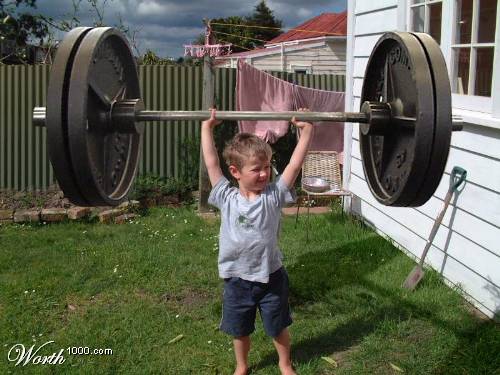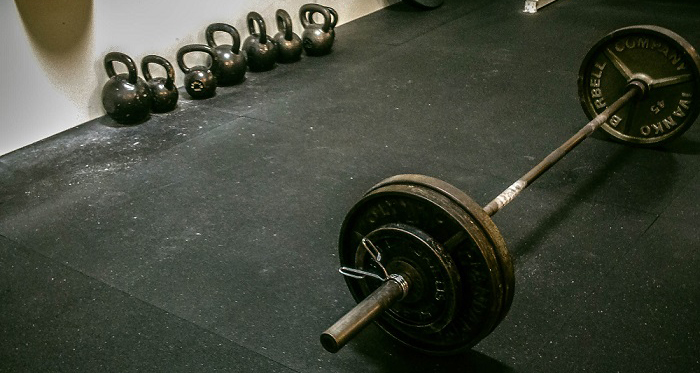The concept of lifting weights can be pretty puzzling to a lot of trainees. Their first and only inclination is to associate weight training with gaining mass and getting bigger overall.
While weight training CAN lead to increased muscle mass, it won't guarantee you become a pro bodybuilder overnight.
On the flipside, weight training is extremely effective means of exercise for those looking to shed some extra body fat.
While weight training CAN lead to increased muscle mass, it won't guarantee you become a pro bodybuilder overnight.
On the flipside, weight training is extremely effective means of exercise for those looking to shed some extra body fat.
So let’s talk about training for fat loss, and what you should consider if you’re trying to get the most out of your efforts.
Prioritize Frequency Over Volume
Over many years of training, I’ve tried a lot of different approaches, both for myself, and for clients. At the end of the day, I’ve learned that just about everything works (aside from various extremes), but nothing works forever, and some things only work during times of extremely low stress and the best of environments (think of the kids in college with no bills, raging hormones, mommy and daddy’s money to spend, and very little anxiety or real-world problems to deal with).
To maintain your muscles, you have to use them by applying resistance frequently enough to make sure that your body pulls body fat for fuel.
In saying that, I like to put a focus on frequency with volume spread out over the week, rather than high volume sessions where you hammer away at a muscle group once every 6-7 days.
Muscle protein synthesis occurs anywhere from 24-48 hours post resistance training, therefore it makes sense to train more frequently if recovery is not impeded (remember, don’t just annihilate your muscles every single session).
And assuming you’re getting adequate protein intake on your weight loss diet plan, you’ll be good to maintain and maybe even build some muscle while you’re at it.
It's beneficial to have you training 3-4 times per week with a frequency of hitting muscle groups 2-3 times per week. Hitting each muscle group even more frequently than this can work extremely well as long as the training volume is managed well.
Sleep, Recovery, Food:
All things not to be overlooked, of course.
With regards to getting enough sleep, the more rest you can get on a diet, the better your recovery will typically be. The better you recovery, the better you’ll feel and perform, and the likelihood of lower stress hormones, which are catabolic.
Recovery is typically gauged in various ways. Here are some questions to think about:
If you answered no to more than a few of these, your recovery might be hindered somewhat.
The recovery process is one that requires an ability to manage the push and pull. Eating well enough to give yourself the nutrients you need, and also allowing for fat loss is not hard, but requires some effort. For more ideas on food, read more about how to create your fat loss diet.
Prioritize Frequency Over Volume
Over many years of training, I’ve tried a lot of different approaches, both for myself, and for clients. At the end of the day, I’ve learned that just about everything works (aside from various extremes), but nothing works forever, and some things only work during times of extremely low stress and the best of environments (think of the kids in college with no bills, raging hormones, mommy and daddy’s money to spend, and very little anxiety or real-world problems to deal with).
To maintain your muscles, you have to use them by applying resistance frequently enough to make sure that your body pulls body fat for fuel.
In saying that, I like to put a focus on frequency with volume spread out over the week, rather than high volume sessions where you hammer away at a muscle group once every 6-7 days.
Muscle protein synthesis occurs anywhere from 24-48 hours post resistance training, therefore it makes sense to train more frequently if recovery is not impeded (remember, don’t just annihilate your muscles every single session).
And assuming you’re getting adequate protein intake on your weight loss diet plan, you’ll be good to maintain and maybe even build some muscle while you’re at it.
It's beneficial to have you training 3-4 times per week with a frequency of hitting muscle groups 2-3 times per week. Hitting each muscle group even more frequently than this can work extremely well as long as the training volume is managed well.
Sleep, Recovery, Food:
All things not to be overlooked, of course.
With regards to getting enough sleep, the more rest you can get on a diet, the better your recovery will typically be. The better you recovery, the better you’ll feel and perform, and the likelihood of lower stress hormones, which are catabolic.
Recovery is typically gauged in various ways. Here are some questions to think about:
- Are you getting a good night’s rest (ie: sleeping uninterrupted for 8-9 hours)?
- Are you feeling fresh in the gym, or run down?
- Are you maintaining your intensity (weight on the bar, ability to push yourself)?
- Do you look forward to training, and being active?
- Do you find it easy, mentally, to get to the gym?
If you answered no to more than a few of these, your recovery might be hindered somewhat.
The recovery process is one that requires an ability to manage the push and pull. Eating well enough to give yourself the nutrients you need, and also allowing for fat loss is not hard, but requires some effort. For more ideas on food, read more about how to create your fat loss diet.
Some Popular Training Methods For Fat LossAs I mentioned above, most everything works, but nothing works forever.
Some programs are indeed more ideal than others when you want fat loss, but all in all, how you deal with it all psychologically is probably more important than any amount of training program mental masturbation (overthinking the optimal) you might embark on.
Some prefer metabolic programs, and conditioning types of training, while others like to train like a powerlifter when dieting.
Here’s what you need to know — as long as it’s intense enough, and you can recover adequately, you’ll maintain muscle, and maybe even build some.
Some popular methods of training for fat loss include:
Which is best?
They all work, and they’re all good methods of helping you lose fat, and maintain lean body mass.
One note I will make about super low volume programs is this: They can work, and some work well, but in my experience most of us need practice with the movements.
Lifting maximally once per week on a major lift (like the bench, deadlift, squat) can head south quickly. Here’s how:
Here’s what I recommend:
For most of the people i work with personally, we will start off their sessions with some type of movement that has a strength-focus, but we’re not resting for long periods (anything longer than 2 minutes). We’ll use rep range of 4-8 for these movements, and aim for a few top sets.
Once these are over, I love to have them work their entire body with multiple movements, typically 1-2 supersets. So if we’re starting off with a drop set of 4×4 weighted chins, I might follow it up with 3-4 sets of pushups supersetted with machine rows with very little to no rest between sets.
We’ll rest for about 2 minutes after the superset, and then move onto another movement group I feel is best for them. After that’s over, we’ll rest again for another 2-3 minutes.
And depending on the focus, and goal, some type of ab or arm work is thrown in to finish it off — typically for 3-4 movements for a complex at the end. Some call it a finisher. Others call it conditioning.
Most everyone agrees that it sucks.
The Criteria Is Simple:
Some programs are indeed more ideal than others when you want fat loss, but all in all, how you deal with it all psychologically is probably more important than any amount of training program mental masturbation (overthinking the optimal) you might embark on.
Some prefer metabolic programs, and conditioning types of training, while others like to train like a powerlifter when dieting.
Here’s what you need to know — as long as it’s intense enough, and you can recover adequately, you’ll maintain muscle, and maybe even build some.
Some popular methods of training for fat loss include:
- Supersetting (doing multiple sets of 2 exercises back to back)
- Employing complexes (basically supersets, but with more than 2 movements / can also be referred to as a circuit)
- Heavy strength training with conditioning finishers at the end
Which is best?
They all work, and they’re all good methods of helping you lose fat, and maintain lean body mass.
One note I will make about super low volume programs is this: They can work, and some work well, but in my experience most of us need practice with the movements.
Lifting maximally once per week on a major lift (like the bench, deadlift, squat) can head south quickly. Here’s how:
- It can take a long time (up to a week) to recover, and you’re at a higher risk for energy when constantly going for personal records.
- You run the psychological risk of getting demotivated, or creating unnecessary anxiety around whether or not you’ll get stronger during the next training session.
- If you’re mentally tied to the idea that strength increases or maintenance = muscle gain, and moderate strength losses = muscle loss, then you might find it very easy to beat yourself up over things that don’t matter much.
Here’s what I recommend:
For most of the people i work with personally, we will start off their sessions with some type of movement that has a strength-focus, but we’re not resting for long periods (anything longer than 2 minutes). We’ll use rep range of 4-8 for these movements, and aim for a few top sets.
Once these are over, I love to have them work their entire body with multiple movements, typically 1-2 supersets. So if we’re starting off with a drop set of 4×4 weighted chins, I might follow it up with 3-4 sets of pushups supersetted with machine rows with very little to no rest between sets.
We’ll rest for about 2 minutes after the superset, and then move onto another movement group I feel is best for them. After that’s over, we’ll rest again for another 2-3 minutes.
And depending on the focus, and goal, some type of ab or arm work is thrown in to finish it off — typically for 3-4 movements for a complex at the end. Some call it a finisher. Others call it conditioning.
Most everyone agrees that it sucks.
The Criteria Is Simple:
- make the session very intense
- keep it under 60 minutes (including warm-ups)
- spread the volume over the week to hit each muscle group 2-4 times every 7 days
- 3-4 sessions per week is usually enough for most people
- use the strength movements as a means to track progress (especially if it helps with motivation)
Stick to the recommendations made above and your weight training program will prove to be an essential part of your over-all diet and fitness plan.
Happy lifting!
Happy lifting!


